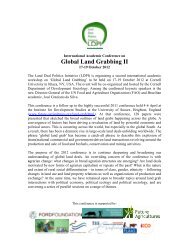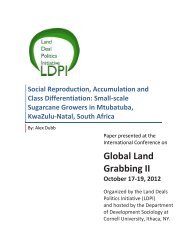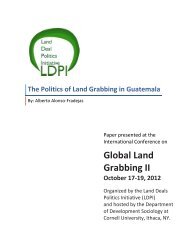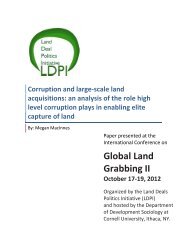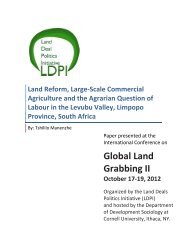Theorizing Sovereignty in Empty Land - Contested Global Landscapes
Theorizing Sovereignty in Empty Land - Contested Global Landscapes
Theorizing Sovereignty in Empty Land - Contested Global Landscapes
- No tags were found...
Create successful ePaper yourself
Turn your PDF publications into a flip-book with our unique Google optimized e-Paper software.
ignorant of the laws govern<strong>in</strong>g collective lands. While villages had control over the lands with<strong>in</strong> their<br />
borders, village boundaries were customary--they had never been formalized by the state--and the<br />
collective land beyond those boundaries was under the purview of the tribe's collective land<br />
representative. The villages abutt<strong>in</strong>g the CSP allotment felt the land was theirs and they should receive<br />
the sale proceeds, unaware that their sovereignty ended with the borders of the village <strong>in</strong> favor of a<br />
sovereignty held by their tribal confederation and vested <strong>in</strong> the person of their land representative. Nor<br />
did people understand that the money from the sale was not go<strong>in</strong>g to be handed over to people <strong>in</strong><br />
<strong>in</strong>dividual allocations. People expected to receive monetary compensation for the project and village<br />
residents close by felt they deserved more. They had to be told that the entire sale price would go <strong>in</strong>to the<br />
tribe's account at the M<strong>in</strong>istry of Interior and used to f<strong>in</strong>ance development projects for the benefit of the<br />
whole area. In essence, the sale was not a sale at all: it was a transfer of funds from one government<br />
agency to another, <strong>in</strong> an expression of the M<strong>in</strong>istry of Interior's ongo<strong>in</strong>g tutelary authority over collective<br />
lands and the tribes that owned them.<br />
This br<strong>in</strong>gs me back to the vignette I started with--the land occupation timed to co<strong>in</strong>cide with the<br />
K<strong>in</strong>g's visit. The idea that people were culturally predisposed to care about the land--an argument used as<br />
easily by government officials as by anthropologists like myself who assert the multivalent cultural<br />
significance of land <strong>in</strong> an effort to counter productivist notions of its economic value--misses the<br />
chang<strong>in</strong>g importance of land <strong>in</strong> people's livelihood systems. The people who occupied land <strong>in</strong> the steppe<br />
where I did my fieldwork responded to a similar set of concerns as the residents protest<strong>in</strong>g the way their<br />
land was sold <strong>in</strong> Ait Oukrour. <strong>Land</strong> that had previously been used for pastoralism was now be<strong>in</strong>g mixed<br />
up <strong>in</strong> new forms of valuation and tenure regimes had not adapted to the new economic realities of their<br />
lives. For thirty years and throughout the region, people had been escap<strong>in</strong>g the drought stricken<br />
mounta<strong>in</strong>s mov<strong>in</strong>g <strong>in</strong>to the steppe for hous<strong>in</strong>g or, where water was available, to expand their agricultural<br />
operations. Expand<strong>in</strong>g urban centers were <strong>in</strong>crementally appropriat<strong>in</strong>g collective lands for city services<br />
and hous<strong>in</strong>g, while larger agricultural projects were appear<strong>in</strong>g <strong>in</strong> the open steppe thanks to long term<br />
rental contracts signed through the same M<strong>in</strong>istry of Interior allocation committees. <strong>Land</strong> was <strong>in</strong>creas<strong>in</strong>g<br />
20



